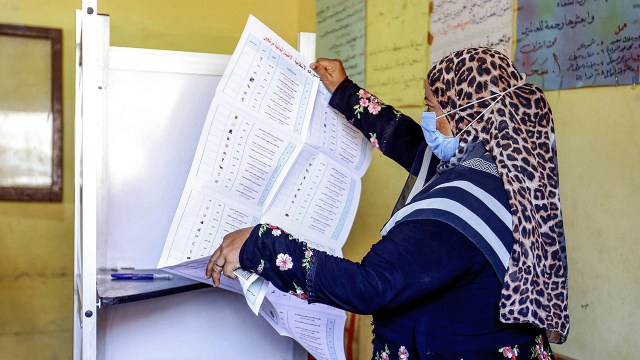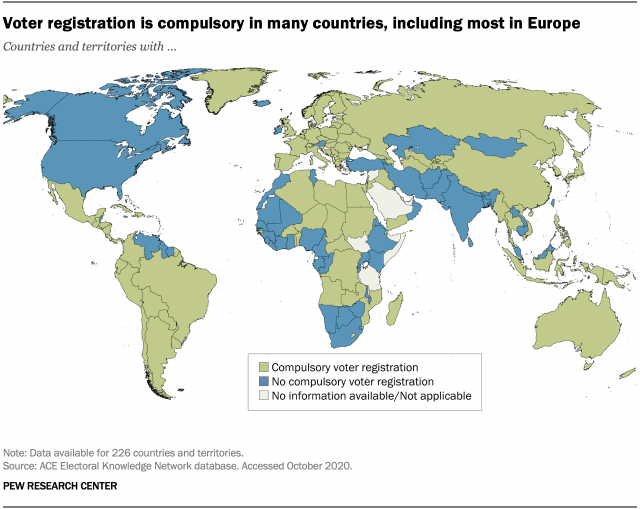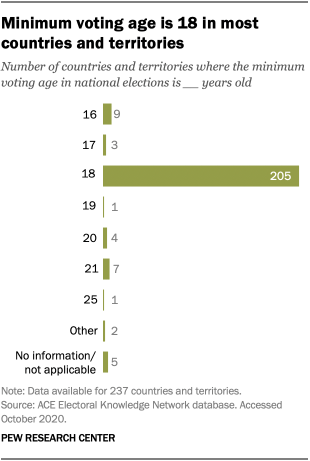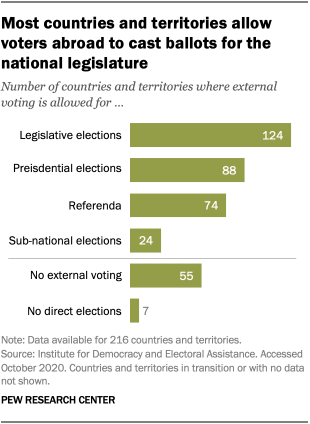
The 2020 U.S. presidential election is unfolding amid a pandemic and public uncertainty over some aspects of the voting process itself. Here’s a look at how elections are run in the United States and other countries around the world. All findings are based on a Pew Research Center analysis of data from the International Institute for Democracy and Electoral Assistance, the ACE Electoral Knowledge Network and the Electoral Integrity Project.
As Election Day approaches in the United States, we conducted this analysis to identify how key components of the electoral process differ across countries. This analysis is based on information from the International Institute for Democracy and Electoral Assistance (IDEA), the ACE Electoral Knowledge Network and the Electoral Integrity Project. The number of countries and territories in this analysis ranges from 166 to 237, depending on the data source and the specific measure being evaluated.
More than half of all countries and territories have compulsory voter registration. Though the exact policy varies from one place to another, 122 of the 226 countries and territories in the ACE Electoral Knowledge Network have some form of compulsory voter registration. In Argentina, Chile, Hungary, Israel, the Netherlands and elsewhere, such registration is automatic, based on government records such as census counts. In other cases, qualified residents are required to register themselves. Failing to register is punishable by a fine in some places, including New Zealand, Tonga and the United Kingdom.
Another 90 countries and territories have no laws requiring all qualified residents to register to vote, though registration may be required in order to vote. In India – the world’s largest democracy – and Mongolia, voter rolls are compiled automatically through census data collection, though registration is not compulsory. In Austria, voter registration and voting itself were compulsory in at least one province until 2004; today, there is no requirement to register or to vote in Austrian elections. There is no compulsory voter registration in the U.S., though registration is necessary in order to vote in nearly all states and U.S. territories (North Dakota does not have voter registration).
The vast majority of countries and territories have a minimum voting age of 18 for national elections. The U.S. aligns with most other places in this respect. Out of 237 countries and territories for which the ACE Electoral Knowledge Network has data, 205 have a minimum voting age of 18. Just 12 countries or territories allow people younger than 18 to vote in national elections.
Worldwide, the lowest minimum voting age for national elections is 16, including in Argentina, Austria and Brazil. The highest is in the United Arab Emirates, where citizens must be 25. In Italy, there is a split voting age: The minimum voting age for the lower house of Parliament is 18 years old, while voters must be 25 to vote in Senate elections.
Before the coronavirus outbreak, about a quarter of countries had used postal ballots in their national elections. Out of 166 countries for which data is available, 40 used postal ballots in their most recent national election, according to country experts surveyed before the COVID-19 outbreak by the Electoral Integrity Project. Postal ballots were used most widely in Europe and North America and are also common in some countries in the Asia-Pacific region, such as India, Indonesia, South Korea and Sri Lanka. Postal ballots were not available in most African and Caribbean countries, and not available in any Middle Eastern or Latin American countries.
Paper ballots are by far the most common form of voting. Votes are cast by manually marking ballots in 209 of the 227 countries and territories for which the ACE Electoral Knowledge Network has data. In some places, voters make their selection by placing a symbol – such as an X, cross or checkmark – on a paper ballot that contains the entire list of candidates and/or parties. In a few countries, including Israel and Mali, voters select a ballot for a particular political party, put the ballot in an envelope and then deposit the envelope in a ballot box.
Some countries use a mix of methods. In addition to paper ballots, electronic voting machines are used in about 10% of the countries and territories for which data is available. Electronic voting machines are used in some large countries, such as India and the U.S., as well as in smaller ones like Singapore.
Voting by internet is used in four countries: Armenia, Canada, Estonia and Switzerland. In Gambia, meanwhile, the most recent presidential election relied on a system of placing marbles into drums. The system was established in the 1960s to address high levels of illiteracy.
Most countries and territories allow voters abroad to cast ballots in some capacity. That’s the case in the U.S. and another 151 of the 216 countries and territories evaluated by the International Institute for Democracy and Electoral Assistance, at least for national legislative, European Parliament or presidential elections. Among those, many allow external voting for legislative elections (124), presidential elections (88) or referenda (74), and just 24 allow it for sub-national elections.
Nearly every country in Europe provides for some form of external voting, and many allow citizens to vote from abroad for multiple types of elections. Most European Union countries (23 of 27) also allow citizens abroad to vote in European Parliamentary elections.
Around the world, 55 countries and territories do not allow any voting from abroad. Many of these countries are located in Latin America, sub-Saharan Africa and the Asia-Pacific region.



